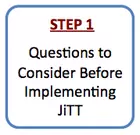Pre-Planning: Getting Started using JiTT in the Classroom
What do you want your students to be able to do and know at the end of your course?
Before you implement JiTT, determine the student learning outcomes you want to achieve and how JiTT can help you and your students more effectively achieve those outcomes. Once you decide on what learning outcomes you want to emphasize, intentionally link JiTT questions to these outcomes.
What instructional technology tools will you use to implement JiTT?
JiTT is easily integrated in most standard web-based course/learning management systems such as Blackboard, Moodle, and Sakai (among others) that you and your students are already using, eliminating the need for learning any additional instructional technology tools. All include options for both open-ended and multiple-choice assessments, which can be made available to students for specific periods of time. Using learning management systems also makes it easy for you to both review and grade student responses, cut-and-paste student responses for viewing in class, or make comments directly to students online.
In what course(s) do I want to use JiTT?
What are the characteristics of those courses in which you plan to implement JiTT? Are they large or small classes, introductory or higher-level, theoretical or applied, discussion or lecture-oriented? JiTT can easily be implemented in any type of course, but how you implement JiTT, both in the types of questions you use and the way that you use student responses in class will depend on your answer to these questions. No matter the course, JiTT will require some additional time, especially the first time you use it, but the increase in student engagement is generally worth it.
What other activities do you plan to include in your course?
JiTT does increase the workload, both for students and instructors, so you need to think about what other activities you also include in your course. Overloading either your students or yourself will defeat the purpose of incorporating JiTT in the first place. Including JiTT may mean having to leave some other activities out, or you might integrate JiTT into existing activities to increase their learning potential.
What activities and teaching strategies will you use as a follow-up to students' JiTT responses?
JiTT is especially effective when combined with in-class hands-on, active-learning activities carried out in small groups using structured cooperative learning techniques. Students' JiTT responses provide a context or focus for in-class activities and teaching practices that actively involve students in the learning process.
How often will you use JiTT exercises?
Ultimately, you may want to use JiTT exercises every week, or possibly even more often. But when you first implement JiTT in a course, you may wish to build exercises in gradually. You can begin with a few JiTT exercises in one semester and add more each time you teach the course. In time, as you add more JiTT exercises in, you will see reduced course preparation work, the ability to grade more efficiently, and greater facility with using student responses to develop effective, student-centered in-class activities. JiTT works best when it is used regularly throughout the semester to provide systematic feedback to students on their learning and included as a formal part of course assessment.
Can JiTT be used in large-enrollment courses?
JiTT is a valuable addition to large enrollment lecture-based courses. JiTT exercises provide prompt feedback about student learning, feedback that is difficult to achieve with other teaching methods, especially in large classes. Moreover, JiTT can be combined with other pedagogical innovations such as Peer Instruction (see references on Peer Instruction) to promote interactive student engagement, even in classes with hundreds of students.
What percentage of the course grade will JiTT account for?
Experience has shown that JiTT works best when it counts as part of the course grade. But how much? Making JiTT count for around 10% of the course grade is typically enough to promote student completion of JiTT exercises while maintaining its primary function as a formative assessment tool. Some faculty members have made JiTT count for as much as 30% of the course grade, however. Of course, the percentage of the final grade that comes from JiTT exercises should be proportional to the number of them that you use. Taking into account that JiTT questions focus on material that has not yet been covered in class, grading is based largely on effort. Sharing the rubric used to evaluate JiTT responses with students will help them to better understand this formative assessment process.
How will you prepare students for completing JiTT exercises?
Most students will be unfamiliar with the JiTT process and may initially view JiTT exercises as "busy work." Explaining the role of JiTT as an effective, student-centered teaching/learning tool in your course syllabus will help students better understand their active role in the learning process. Once understood, students generally view JiTT quite favorably and wish that other instructors also used this teaching technique.










